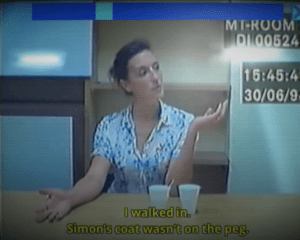The game “Her Story” by Sam Barlow, is available on multiple platforms, including PC, Mac, iOS, and Android. The target audience for this game is primarily fans of interactive storytelling and mystery enthusiasts. The thrilling investigative experience has no formal age limit.
The important formal elements of the game include a nonlinear narrative structure, live-action video clips, and a database search interface. Players advance the story by querying a database of police interviews, piecing together the truth behind a mysterious crime. The game effectively combines interactive elements with compelling storytelling, creating an engaging and thought-provoking experience.
“Her Story”s primary type of fun is discovery, or game as uncharted territory, and narrative. In terms of discovery, players gradually uncover the truth and make their own conclusions about the case. Alongside this the element of narrative focuses on the captivating and intellectually stimulating storyline and investigative experience.
One of the moments of particular success in “Her Story” is when players start connecting the dots and uncovering key revelations. The game’s non-linear nature allows players to piece together the story in their own order, leading to moments of excitement and discovery. These moments of epiphany add depth and intrigue to the overall experience. As I played like a designer, I analyzed when I experienced a major emotion and whether it was reacting to the suspect saying
“I was planning to have a baby with him”
to the excitement around figuring out a piece of the puzzle, I was enthralled by the puzzle and narrative simultaneously. Also, a good designer plays all games, and I fought the inner question of
“why not just watch a movie”
as opposed to playing a narrative type of fun game.
However, one area where “Her Story” could improve is in providing additional replay value. Once players have completed the game and uncovered the truth, there is little incentive to revisit it. Adding additional content, such as new interview clips or alternative story paths, would enhance the game’s replayability and extend its overall lifespan. Since the game emphasizes the challenge of figuring out the mystery in a narrative sense as opposed to an obstacle course sense, there is a low incentive to replay the game. To address this, a potential change to make the game better, would be addressing this lack of replayability. Adding an aspect of personalization, like inputting your college’s zip code or information that is not too sensitive could be really fun for personalization and intriguing the user in small ways. Maybe the suspect went to Coupa Cafe before she last saw her future husband. This simple way of plugging in basic information with the use of AI could make the game exciting for many replays to come. Again in terms of playing like a designer, this would be a first order optimal strategy, as such a small technical change would be a major value add for gameplay, and is a practical solution.
Analyzing the game in terms of arcs, loops, etc, we notice that players will come across certain clips multiple times, forming loops in the story. However, each time the player revisits a particular clip, they may be attuned to new information or insights that they missed before through hints or just rewatching. Bigger milestones tended to represent arcs, like finding out where the husband went, the murder weapon, etc. would represent the end of an arc, or the resolution of events building up, since “arcs deliver success”. Therefore, the game feels to be linearly a sequence of arcs with loops repeatedly occurring throughout. “Her Story” was a great game to analyze with arcs and loops in mind: it had both.
How does the architecture of the setting control the story? How is the narrative woven into the mystery, and how do the mechanics support the mystery? The setting of gathering information through a database with certain filters and not exhaustive access helps restrict the story. This controlled access to information creates a sense of mystery and intrigue, as players must piece together the story based on the limited information they have – contributing to game play fun. The mechanics of the game alongside the formal element’s procedure (the way to find out information through clue-finding)



